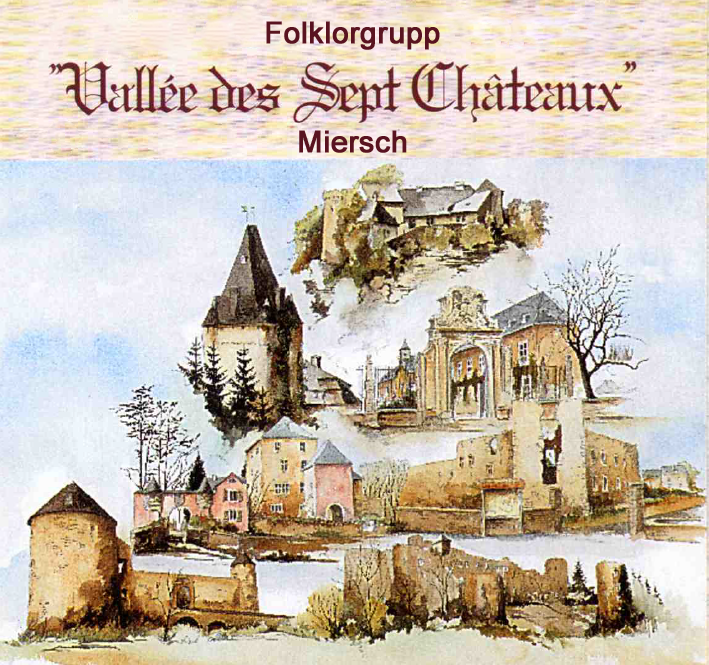ABOUT US
The aim of the Vallée des Sept Châteaux folklore group from Mersch is to preserve folk dance as a form of intangible cultural heritage and to pass it on to future generations. The dances performed range from the middle ages to the 19th century and were danced in Luxembourg and in its neighbourhood: the regions that used to compose the former Duchy of Luxembourg. Most of the dances originate from the 18th and the 19th century.
The folklore group of Mersch aims to reproduce the dances as authentically as possible while reviving the traditions for the youth using the modern slogan "Lët'z Folk" standing for Lëtzebuerger Folklor.
The group was founded in 1952, on the occasion of a historical procession in Mersch. Since that time, Luxembourgish folklore has been kept alive by dynamic group.
Nowadays, the repertoire of the group has a repertoire of 25 dances and is rich enough to provide a diverse program for more than one hour. The figures and steps have been passed over from one person to the other, and the choreographies have been performed with slight variations from region to region.
Some dances, such as the Karschnatz or the Stréinen Hunn, were danced at country fairs. Others, like the Ronn or the Véiereckeg Maclotte, came from the court or the bourgeoisie. The dances incorporated everyday social situations such as flirting, love or even quarrelling – like in the Valse Rosse. The young men wanted to impress the girls and the girls wanted to seduce the men with their dance. Many of the dance names hide the origin of the dances themselves: Maclotte d'Hâbièmont or Contredanse de Bastogne, for example. The repertoire of the group also includes children’s dances, such as the Schleek or the Siwesprong, that are still practised in elementary school today.
The costumes are reproductions of the traditional garments worn in the 18th century and had been prepared on the basis of the research carried out by the historian Alain Atten. The one-piece coat worn by the musicians imitates the officers' uniform of the "Brotherhood of Young People" that was used in the rural areas, as well as by commoners.
The group's affiliation to CIOFF®, the International Council of Organizations of Folklore Festivals and Folk Arts, gave the dancers the possibility to visit the greatest folk festivals of the world held so far in more than 40 countries, as representatives of the oldest form of the cultural life of Luxembourg. In return, more than 35 nations (+8000 participants) gave guest performances in Mersch. Now the group is affiliated CIOFF® International through UGDA, the Federation Nationale de Musique du Grand-Duché de Luxembourg.
LUXEMBOURG IN THE HEART OF EUROPE
Luxembourg is a real "holiday country", with a pleasant climate, a beautiful scenery and a lot of wonderful castles, palaces and churches which have been restored in a specific style and with a lot of care. The network of well-marked walking paths covers the whole country, making it a joy to discover it.
The Grand Duchy of Luxembourg is an independent sovereign state, a constitutional monarchy, the ruling of which is hereditary in the House of Nassau. The present ruler, Grand Duke Henri assumed the throne in October 2000. He is married to Maria Teresa, Grand Duchess of Luxembourg. The population of the country is about 640 000. One-third of the country, which has 2 587 square kilometres or about 1 000 square miles, is covered by forests. Geographically, the Grand Duchy is divided into two sections: the uplands of the Ardennes, a scenic region of hills in the North, and Guttland ("good land") with its rolling farmlands and woods in the South, bordered by the lovely grape-growing region, the Valley of the Moselle from the East. We can find the former mining district in the southernmost area of Luxembourg.
The country has three official languages: French, German and Luxembourgish, with the latter one being the colloquial language. Almost everyone speaks French and German, too, and more and more people speak English.
MERSCH IN THE HEART OF LUXEMBURG
The seat of our group is Mersch, the administrative centre of a community of 10 005 inhabitants. The village lies at the crossroad of tourist routes right in the middle of the country. It is considered the gate of the "Valley of the Seven Castles". The name refers to the feudal castles of Schönfels, Ansembourg, Hollenfels, Simmern, Koerich and the two castles of Mersch which are connected by forest walks through beautiful scenery. The landscape hides unexpected treasures such as the springs of Hunnebour or the prehistoric caves of the Mamer and Dreibouren. Remains of a Roman villa, St. Michael's Tower with a carillon, churches, the Centenary Column... the area offers plenty to discover. Mersch is also a first-class recreation centre with a public park, a swimming pool and many well-marked walking paths.
August 2021











